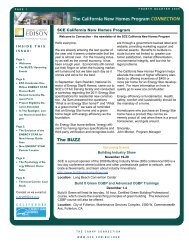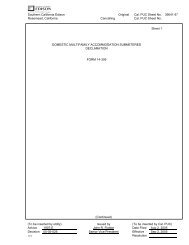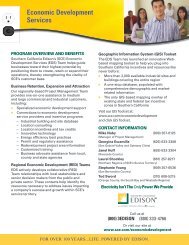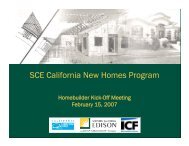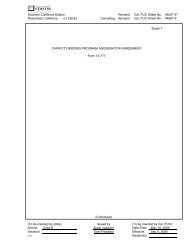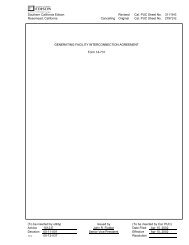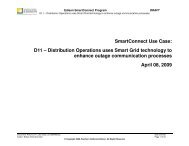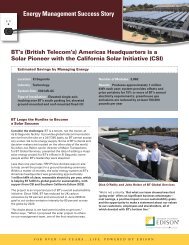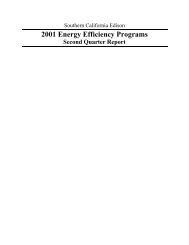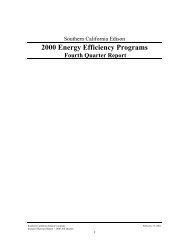Dear Customer: Your inquiry about electric and magnetic fields is ...
Dear Customer: Your inquiry about electric and magnetic fields is ...
Dear Customer: Your inquiry about electric and magnetic fields is ...
You also want an ePaper? Increase the reach of your titles
YUMPU automatically turns print PDFs into web optimized ePapers that Google loves.
-*- Demonstration Powered by HP Exstream 08/29/2011, Version 7.0.613 64-bit -*-<br />
Underst<strong>and</strong>ing EMF<br />
(ELECTRIC AND MAGNETIC FIELDS)<br />
Questions have been ra<strong>is</strong>ed <strong>about</strong> the possible health effects of 60-hertz (power<br />
frequency) <strong>electric</strong> <strong>and</strong> <strong>magnetic</strong> <strong>fields</strong> (EMF*), which are found wherever you have<br />
<strong>electric</strong> power. Th<strong>is</strong> article contains information that will help you underst<strong>and</strong> the<br />
EMF <strong>is</strong>sue, plus practical tips you can use if you want to reduce your exposure at<br />
home <strong>and</strong> at work.<br />
Can EMF Harm <strong>Your</strong> Health?<br />
Electric <strong>and</strong> <strong>magnetic</strong> <strong>fields</strong> are present wherever <strong>electric</strong>ity flows—around<br />
appliances <strong>and</strong> power lines, <strong>and</strong> in offices, schools <strong>and</strong> homes. Many researchers<br />
believe that if there <strong>is</strong> a r<strong>is</strong>k of adverse health effects from usual residential<br />
exposures to EMF, it <strong>is</strong> probably just at the detection limit of human health studies;<br />
nonetheless, the possible r<strong>is</strong>k warrants further investigation. The varying results<br />
from epidemiological studies, which looked at estimated EMF exposures <strong>and</strong><br />
childhood leukemia, are cons<strong>is</strong>tent with a weak link. Laboratory studies, including<br />
studies investigating a possible mechan<strong>is</strong>m for health effects (mechan<strong>is</strong>tic studies),<br />
provide little or no evidence to support th<strong>is</strong> weak link.<br />
The results from many research studies have been evaluated by international,<br />
national <strong>and</strong> California EMF research programs to determine whether EMF poses<br />
any health r<strong>is</strong>k. Given the uncertainty of the <strong>is</strong>sue, the medical <strong>and</strong> scientific<br />
communities have been unable to conclude that usual residential exposures to EMF<br />
cause health effects, or to establ<strong>is</strong>h any st<strong>and</strong>ard or level of residential exposure<br />
that <strong>is</strong> known to be either safe or harmful. These conclusions remain unchanged by<br />
recent studies.<br />
World Health Organization Findings<br />
The World Health Organization (WHO) completed a review of the potential health<br />
implications of extremely low frequency (ELF) EMF, which includes power-frequency<br />
<strong>fields</strong>. Their conclusions <strong>and</strong> recommendations were presented in June 2007 in a<br />
report known as the Extremely Low Frequency Fields, Environmental Health Criteria<br />
Monograph No. 238.<br />
The WHO report concluded that evidence for a link between ELF <strong>magnetic</strong> <strong>fields</strong><br />
<strong>and</strong> childhood leukemia “<strong>is</strong> not strong enough to be considered causal but<br />
sufficiently strong to remain a concern.” “Virtually all of the laboratory evidence <strong>and</strong><br />
the mechan<strong>is</strong>tic evidence fail to support” th<strong>is</strong> reported association. For all other<br />
d<strong>is</strong>eases, there <strong>is</strong> inadequate or no evidence of health effects at low exposure<br />
levels.<br />
The report emphasized that, given the weakness of the evidence for health effects,<br />
the health benefits of exposure reduction are unclear <strong>and</strong> adopting policies based<br />
on arbitrary low exposure limits <strong>is</strong> not warranted. In light of th<strong>is</strong> situation, WHO<br />
made these <strong>and</strong> other recommendations:<br />
♦ National authorities should implement communication programs with all<br />
stakeholders to enable informed dec<strong>is</strong>ion-making, including how individuals can<br />
reduce their own exposure.<br />
♦ Policy makers <strong>and</strong> community planners should implement very low-cost<br />
measures to reduce exposures when constructing new facilities <strong>and</strong> designing<br />
new equipment, including appliances.<br />
♦ Policy makers should establ<strong>is</strong>h guidelines for ELF field exposure for both the<br />
general public <strong>and</strong> workers. The best source of guidance for both exposure levels<br />
<strong>and</strong> the principles of scientific review are the international guidelines.<br />
♦ Government <strong>and</strong> industry should promote research to reduce the uncertainty of<br />
the scientific evidence on the health effects of ELF field exposure. Several<br />
recommended research projects are already under way through the Electric<br />
Power Research Institute, of which SCE <strong>is</strong> a member.<br />
To view the full report <strong>and</strong> a fact sheet summarizing it, v<strong>is</strong>it<br />
www.who.int/peh-emf/publications/elf_ehc/en/index.html<br />
www.who.int/mediacentre/factsheets/fs322/en/index.html<br />
What You Can Do<br />
In a situation of scientific uncertainty <strong>and</strong> public concern, WHO recommended that<br />
utilities explore “very low-cost” ways to reduce EMF exposure from new or upgraded<br />
facilities. SCE <strong>and</strong> other California public utilities have been pursuing no-cost <strong>and</strong><br />
low-cost measures to reduce EMF levels from new utility transm<strong>is</strong>sion lines <strong>and</strong><br />
substation projects. You, too, may want to take no-cost <strong>and</strong> low-cost measures to<br />
reduce your EMF exposure at home <strong>and</strong> at work.<br />
Human studies have not produced a consensus <strong>about</strong> any health benefits from<br />
changing the way people use <strong>electric</strong> appliances. But, if you feel reducing your EMF<br />
exposure would be beneficial, you can increase your d<strong>is</strong>tance from <strong>electric</strong><br />
appliances <strong>and</strong>/or limit the amount of time you use appliances at home or at work.<br />
September 2011<br />
Page 7 of 8<br />
For instance, you can place phone answering machines <strong>and</strong> <strong>electric</strong> clocks away<br />
from the head of your bed. Increasing your d<strong>is</strong>tance from these <strong>and</strong> other appliances<br />
such as telev<strong>is</strong>ions, computer monitors <strong>and</strong> microwave ovens can reduce your EMF<br />
exposure.<br />
You can also reduce your EMF exposure by limiting the time you spend using<br />
personal appliances such as hair dryers, <strong>electric</strong> razors, heating pads <strong>and</strong> <strong>electric</strong><br />
blankets. You may also want to limit the time you spend using <strong>electric</strong> cooking<br />
appliances.<br />
You can locate the sources of EMF in your work environment, <strong>and</strong> spend break time<br />
in lower-field areas.<br />
It <strong>is</strong> not known whether such actions will have any impact on your health.<br />
Additional Information Is Available<br />
SCE provides free EMF information packages <strong>and</strong> home/business measurements<br />
upon request. We also invite you to attend a workshop on EMF at our EMF Education<br />
Center located in Irwindale. For any of these services, please call us at<br />
1-800-200-4SCE. Additional information <strong>is</strong> also available at these links:<br />
EMF Basics:<br />
www.who.int/peh-emf/<strong>about</strong>/What<strong>is</strong>EMF/en/<br />
www.niehs.nih.gov/health/assets/docs_p_z/emf-02.pdf<br />
World Health Organization International EMF Project:<br />
www.who.int/peh-emf/en/<br />
National Institute of Environmental Health Sciences:<br />
www.niehs.nih.gov/health/topics/agents/emf/<br />
California Department of Health Services:<br />
www.ehib.org/emf/<br />
California Public Utilities Comm<strong>is</strong>sion:<br />
www.cpuc.ca.gov/PUC/energy/Environment/ElectroMagnetic+Fields/action.htm<br />
Campos Eléctricos y Magnéticos (EMF):Si desea recibir información en español,<br />
comuniquesecon SCE al 1-800-441-2233.<br />
Reviewed by: California Public Utilities Comm<strong>is</strong>sion (CPUC)<br />
*The term EMF in th<strong>is</strong> publication refers to extremely low frequency (ELF)<br />
60-hertz <strong>electric</strong> <strong>and</strong> <strong>magnetic</strong> <strong>fields</strong> associated with power delivered by<br />
<strong>electric</strong> utilities. It does not refer to radio frequency (RF) waves associated<br />
with wireless communications such as cell phones.



